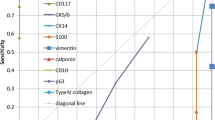Summary
The ductal system of the human breast consists of two major cell types: epithelial and myoepithelial. In some reports a third cell type, given various names is mentioned. In this study it is called a basal clear cell. The role of this cell, unlike that of the epithelial and myoepithelial cells, remains unclear, although it has been suggested that it may have a stem cell function. We illustrate here that there is an ultrastructural transition between the basal clear and myoepithelial cell; suggesting that it acts as a precursor of the myoepithelial cell, and may not be a stem cell for both epithelial and myoepithelial cells.
Similar content being viewed by others
References
Ahmed A (1980) Ultrastructural aspects of human breast lesions. Pathol Annu 15:411–443
Bässler R (1958) Beiträge zur Morphologie der kindlichen Brustdrüse. Frankfurt Z Pathol 69:37–52
Bennett DC (1980) Morphogenesis of branching tubules in cultures of cloned mammary epithelial cells. Nature 285:657–659
Bennett DC, Peachey LA, Durbin H, Rudland PS (1978) A possible mammary stem cell line. Cell 15:283–298
Carter D, Yardley JH, Shelley WM (1969) Lobular carcinoma of the breast. An ultrastructural comparison with certain duct carcinomas and benign lesions. John Hopk Med J 125:25–43
Doerr W, Seifert G, Uehlinger E (1978) Spezielle Pathologische Anatomie. Springer, Berlin Heidelberg New York Band 11 pp 28–88
Fanger H, Ree HJ (1974) Cyclic changes of human mammary gland epithelium in relation to the menstrual cycle - an ultrastructural study. Cancer 34:574–585
Fisher ER (1976) Ultrastructure of the human breast and its disorders. Am J Clin Pathol 66:291–375
Foster CS, Smith CA, Dinsdale EA, Monaghan P, Neville AM (1983) Human mammary gland morphogenesis in vitro: The growth and differentiation of normal breast epithelium in collagen gel cultures defined by electron microscopy, monoclonal antibodies, and autoradiography. Develop Biol 96:197–216
Hamperl H (1970) The myothelia (myoepithelial cells): Normal state, regressive changes, hyperplasia and tumours. Curr Topics Pathol 53:162–220
Mollenhauer HH (1964) Plastic embedding mixture for use in electron microscopy. Stain Technol 39:111–114
Murad TM, Grieder MH, Scarpelli DG (1967) The ultrastructure of human mammary fibroadenoma. Am J Pathol 51:663–679
Murad TM, Von Haam E (1968) The ultrastructure of fibrocystic disease of the breast. Cancer 22:587–600
Ozzello L (1971) Ultrastructure of the human mammary gland. Pathol Annu 6:1–59
Radnor CJP (1972a) Myoepithelium in the prelactating and lactating mammary glands of the rat. J Anat 112:337–353
Radnor CJP (1972b) Myoepithelial cell differentiation in rat mammary glands. J Anat 111:381–398
Reynold ES (1963) The use of lead citrate at high pH as an electron-opaque stain in electron microscopy. J Cell Biol 17:208–212
Rudland PS, Ormerod EJ, Paterson F (1980) Stem cells in rat mammary gland development and cancer, a review. J Roy Soc Med 73:437–442
Russo IH, Russo J (1978) Developmental stage of the rat mammary gland determinant of its susceptibility to 7,12-dimethylbenz(a)anthracene. J Natl Cancer Inst 61:1439–1449
Salazar H, Tobon H (1974) Morphologic changes of the mammary gland during development, pregnancy and lactation. In: Josimovich JB (ed) Lactogenic hormones, fetal nutrition and lactation. John Wiley and Sons, New York pp 221–227
Stempak JG, Ward RT (1964) An improved staining method for electron microscopy. J Cell Biol 22:697–701
Stirling JW, Chandler JA (1976) The fine structure of the normal resting terminal ductal-lobular unit of the female breast. Virchows Arch [Pathol Anat] 372:205–226
Stirling JW, Chandler JA (1977) The fine structure of ducts and subareolar ducts in the resting gland of the female breast. Virchows Arch [Pathol Anat] 373:119–132
Sykes JA, Recher L, Jernstrom PH, Whitescarver J (1968) Morphological investigation of human breast cancer. J Natl Cancer Inst 40:195–223
Tannenbaum M, Weiss M, Marx AJ (1969) Ultrastructure of the human mammary ductule. Cancer 23:958–978
Tobon H, Salazar H (1974) Ultrastructure of the human mammary gland I. Development of the fetal gland throughout gestation. J Clin Endocrinol Metab 39:443–456
Toker C (1967) Observations on the ultrastructure of a mammary ductule. J Ultrastruct Res 21:9–25
Waugh D, Van Der Hoeven E (1962) Fine structure of the human adult female breast. Lab Invest 11:220–228
Author information
Authors and Affiliations
Rights and permissions
About this article
Cite this article
Smith, C.A., Monaghan, P. & Munro Neville, A. Basal clear cells of the normal human breast. Vichows Archiv A Pathol Anat 402, 319–329 (1984). https://doi.org/10.1007/BF00695085
Accepted:
Issue Date:
DOI: https://doi.org/10.1007/BF00695085




